Acoelomate - Study guides, Class notes & Summaries
Looking for the best study guides, study notes and summaries about Acoelomate? On this page you'll find 55 study documents about Acoelomate.
All 55 results
Sort by
 Popular
Popular
-
BIOL 198 Module 7 Objectives with Complete Solutions
- Exam (elaborations) • 33 pages • 2024
- Available in package deal
-
 StellarScores
StellarScores
-
- $10.49
- 1x sold
- + learn more
BIOL 198 Module 7 Objectives with Complete Solutions Identify the characteristics that distinguish animals from other types of organisms. Multicellular Heterotrophic Motile Reproduce sexually Use aerobic metabolism Lack cell walls Have life cycles that include development from undifferentiated cells Have a variety of body plans Distinguish between asymmetry, radial symmetry, and bilateral symmetry. Asymmetry: no particular organization Radial symmetry: Circularly organized...
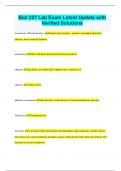
-
Biol 227 Lab Exam Latest Update with Verified Solutions
- Exam (elaborations) • 32 pages • 2024
- Available in package deal
-
 StellarScores
StellarScores
-
- $10.49
- + learn more
Biol 227 Lab Exam Latest Update with Verified Solutions Acoelomate (Platyhelminthes) planaria. has eyespots , auricles, incomplete digestion, pharynx, dorsoventrally flattened acoelomate filled with parenchyma derived from mesoderm albumen egg white, just under shell, supples water, nutrients, o2 allantois collects waste allantois in mammals tube that fuses with chorion to form chorioallantoic placenta Allomyces Chytridiomycota Alveolata A protistan clade that includes d...
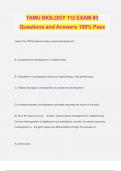
-
TAMU BIOLOGY 112 EXAM #3 Questions and Answers 100% Pass
- Exam (elaborations) • 33 pages • 2024
- Available in package deal
-
 BrittieDonald
BrittieDonald
-
- $13.49
- + learn more
TAMU BIOLOGY 112 EXAM #3 Questions and Answers 100% Pass Select the TRUE statement about animal development: A.) Deuterostome development is indeterminate. B.) Mesoderm in protostomes arises as outpocketings of the primitive gut. C.) Radial cleavage is characteristic of protostome development. D) In deuterostomes, the blastopore ultimately becomes the mouth of the adult. E) All of the above are true. - Answer- Deuterostome development is indeterminate. During embryogenesis of diploblasti...
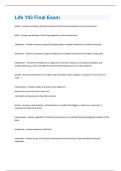
-
Life 103 Final Exam Questions & Answers Already Passed!!
- Exam (elaborations) • 24 pages • 2024
- Available in package deal
-
 PatrickKaylian
PatrickKaylian
-
- $7.99
- + learn more
abiotic - Answer-nonliving: referring to physical and chemical properties of an environment biotic - Answer-pertaining to the living organisms in the environment catabolism - Answer-releases energy by breaking down complex molecules to simpler molecules anabolism - Answer-consumes energy to synthesize a complex molecule from simpler compounds metabolism - Answer-the totality of an organism's chemical reactions, consisting of catabolic and anabolic pathways, which manage the material and en...
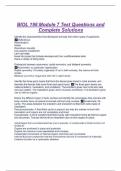
-
BIOL 198 Module 7 Test Questions and Complete Solutions
- Exam (elaborations) • 16 pages • 2024
- Available in package deal
-
 twishfrancis
twishfrancis
-
- $10.49
- + learn more
Identify the characteristics that distinguish animals from other types of organisms. Multicellular Heterotrophic Motile Reproduce sexually Use aerobic metabolism Lack cell walls Have life cycles that include development from undifferentiated cells Have a variety of body plans Distinguish between asymmetry, radial symmetry, and bilateral symmetry. Asymmetry: no particular organization Radial symmetry: Circularly organized. If cut in half vertically, the halves will look similar. Bilateral symmet...
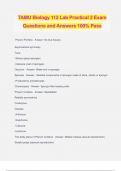
-
TAMU Biology 112 Lab Practical 2 Exam Questions and Answers 100% Pass
- Exam (elaborations) • 23 pages • 2024
- Available in package deal
-
 EmilyCharlene
EmilyCharlene
-
- $12.49
- + learn more
TAMU Biology 112 Lab Practical 2 Exam Questions and Answers 100% Pass Phylum Porifera - Answer- No true tissues Asymmetrical symmetry Taxa: -Silicea (glass sponges) -Calcarea (rest of sponges) Osculum - Answer- Water exit in sponges Spicules - Answer- -Skeletal components of sponges made of silica, calcite or spongin -Produced by amoebocytes Choanocytes - Answer- Spong's filter-feeding cells Phylum Cnidaria - Answer- Diploblastic Radially symmetrical Cnidocytes Classes: -Anthozoa...
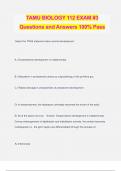
-
TAMU BIOLOGY 112 EXAM #3 Questions and Answers 100% Pass
- Exam (elaborations) • 33 pages • 2024
- Available in package deal
-
 EmilyCharlene
EmilyCharlene
-
- $13.49
- + learn more
TAMU BIOLOGY 112 EXAM #3 Questions and Answers 100% Pass Select the TRUE statement about animal development: A.) Deuterostome development is indeterminate. B.) Mesoderm in protostomes arises as outpocketings of the primitive gut. C.) Radial cleavage is characteristic of protostome development. D) In deuterostomes, the blastopore ultimately becomes the mouth of the adult. E) All of the above are true. - Answer- Deuterostome development is indeterminate. During embryogenesis of diploblasti...
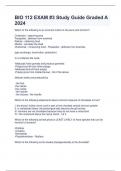
-
BIO 112 EXAM #3 Study Guide Graded A 2024
- Exam (elaborations) • 8 pages • 2024
-
 PossibleA
PossibleA
-
- $11.49
- + learn more
Which of the following is an incorrect match of structure and function? Cnidocyte - capturing prey Parapodia - defense from enemies Radula - obtaining food Mantle - secretes the shell Chelicerae - consuming food - Parapodia - defense from enemies (gas exchange, locomotion, protection) In a cnidarian life cycle, -Medusae have gonads and produce gametes -Polyps bud off from other polyps -Medusae bud off from polyps -Polyps grow from ciliated larvae - All of the above ...
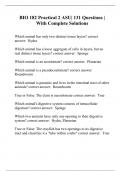
-
BIO 182 Practical 2 ASU| 131 Questions | With Complete Solutions
- Exam (elaborations) • 13 pages • 2023
- Available in package deal
-
 Classroom
Classroom
-
- $13.49
- + learn more
Which animal has only two distinct tissue layers? correct answer: Hydra Which animal has a loose aggregate of cells in layers, but no real distinct tissue layers? correct answer: Sponge Which animal is an acoelomate? correct answer: Planarian Which animal is a pseudocoelomate? correct answer: Roundworm Which animal is parasitic and lives in the intestinal tract of other animals? correct answer: Roundworm True or False: The clam is eucoelomate correct answer: True Which an...
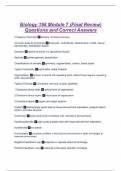
-
Biology 198 Module 7 (Final Review) Questions and Correct Answers
- Exam (elaborations) • 6 pages • 2024
- Available in package deal
-
 twishfrancis
twishfrancis
-
- $8.99
- + learn more
3 Classes of Animals Bacteria, Archaea, Eukarya Common features of animals Eukaryotic, multicellular, heterotrophic, motile, sexual reproduction, specialized tissues Sponges sessile as adults, no specialized tissues daphnia parthenogenetic reproduction Classifications of animals symmetry, segmentation, coelom, tissue layers Types of symmetry asymmetry, radial, bilateral Segmentation division of animal into repeating parts, distinct body regions, repeating units, specialization Types of Ti...

Do you wonder why so many students wear nice clothes, have money to spare and enjoy tons of free time? Well, they sell on Stuvia! Imagine your study notes being downloaded a dozen times for $15 each. Every. Single. Day. Discover all about earning on Stuvia


